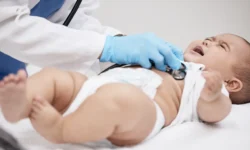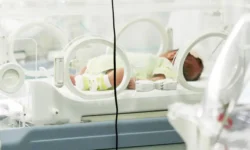What to do if your newborn suffered facial paralysis during birth
A mother and her newborn are quite vulnerable during birth. It’s not uncommon for babies to suffer minor injuries during delivery. If they’re minor, they require no medical intervention and heal on their own.
However, facial paralysis is among the more serious birth injuries that typically require medical intervention.
Facial nerve palsy can be either a result of birth trauma or developmental issues. When the injuries are a result of medical malpractice, you may be able to take legal action. Continue reading to learn about the common causes of facial paralysis in newborns and your legal rights in such situations.
What is facial paralysis?
Facial paralysis is the inability to move facial muscles on one side or on the entire face. It’s a result of nerve damage due to birth injuries, disease or trauma. Facial paralysis can occur suddenly or gradually over some time and results in noticeable drooping of facial features. It might also last for a short or an extended time, depending on the cause.
A child born with facial paralysis may be unable to close their eyes, swallow or produce tears.
Common causes of infant facial paralysis
Facial paralysis occurs when the nerves that control the facial muscles are inflamed or damaged. This can happen due to trauma during birth, disease or being born with it (genetic).
Here are some of the most common causes of facial palsy:
Bell’s Palsy
Although the real cause of Bell’s Palsy remains unknown, it’s the most common form of facial paralysis. It causes sudden weakness of the facial muscles. According to the National Organization of Rare Disorders, up to 40,000 new cases are reported every year in the U.S.
Trauma
Birth trauma can happen anywhere on the body, including the skull or face. Facial nerve paralysis occurs where the nerve exits the skull. This type of trauma can happen during a complicated delivery if the doctor seizes the head of the newborn obliquely during delivery.
Trauma can also be caused by extended labor, large baby size and the use of epidural anesthesia.
Stroke
A stroke occurs when the oxygen supply to the brain is reduced or interrupted. It’s considered a medical emergency since the brain cells begin to die in minutes. In addition to facial paralysis, stroke comes with other symptoms, including dizziness, seizures and weakness in the body’s entire side.
Tumor
Facial paralysis might be the result of a tumor. In such cases, the paralysis progresses over months. It’s usually accompanied by abnormal twitching in the face. Unfortunately, only CT scans and MRIs can uncover tumors.
Signs and symptoms of facial paralysis in newborns
The signs and symptoms of facial nerve palsy vary slightly, depending on the underlying cause. Here are some red flags:
- Loss of facial control, such as blinking on the affected side
- Drooping of the mouth
- Reduced tear production
- Uncontrollable drooling
- Difficulty feeding
- Problems with speech, cooing and crying
- Sound sensitivity on the affected side
Treatment options
Symptoms alone are not enough to determine if a child has facial paralysis. A doctor will have to conduct tests to confirm the condition and determine the extent of nerve damage. Depending on the cause, the doctor will recommend treatment options. There are a few options to consider.
Muscle transfer
Muscle transfer involves the removal of a few muscles or tendons and their relocation to an area where they can restore natural movement, such as:
- Temporalis tendon transfer. One end of the tendon connected to the jaw is relocated closer to the mouth. The tendon helps to control chewing, lifts a saggy mouth and helps to give the child the ability to smile.
- Gracilis transfer. This is a surgical procedure where the gracilis muscles located in the inner thighs are transferred to the neck and head. This procedure is highly specialized and typically requires a few days in the hospital.
Nerve grafting
When nerve function is lost, the muscle in that area of the face degrades over time. However, if a new nerve is transferred to that area quickly enough, grafting can restore the lost nerve function: movement, sensation and muscle control. A good example is the cross facial nerve graft, where a nerve is crossed from the normal side to the affected side.
When to sue for birth-related facial paralysis
As with all health matters, prevention is better than cure. Traumatic facial nerve palsy in newborns is often completely avoidable. It is the doctor’s responsibility to monitor the baby and the mother during pregnancy and at birth.
Physicians must also use birth assistance tools, such as forceps, accordingly. A mistake in judgment, like inducing labor too early, can lead to birth injuries and possible facial paralysis. In such cases, you can sue the facility or the doctor responsible.
Each state has its laws regarding medical malpractice. In Texas, the statute of limitation is 2 years from the injury. An experienced birth injury lawyer will ensure you file a lawsuit on time and win the settlement you deserve.
In states like Texas, there is no cap on economic damages. You will get compensation for past, current and future medical bills. You may also be entitled to compensation for pain and suffering caused by the birth injury.
Hiring an experienced birth injury attorney like Laura Brown helps to protect your rights and guarantees that you receive compensation to help you navigate such difficult times.
Contact us today to schedule your free consultation.
- Cerebral Palsy
- Caput Succedaneum and Cephalohematoma
- Neonatal Intracranial Hemorrhage (Childbirth Brain Bleeds)
- Hydrocephalus (Extra Fluid in the Brain Cavity)
- Cervical Dystonia
- Hemiplegia (Brain or Spinal Cord Injury)
- Hemorrhagic Stroke
- Neonatal Stroke
- HIE
- Periventricular Leukomalacia (PVL) Brain Injury
- Infant Seizures
- Spastic Diplegia (Spasticity in the Legs)
- Top Risks for Birth Injuries
- Fetal Alcohol Syndrome
- Facial Paralysis
- Spinal Cord Injuries
- Bell’s Palsy
- Brachial Plexus Nerves & Erb’s Palsy
- Klumpke’s Palsy
- G-Tubes for Newborns
- Medical Errors
- Cesarean Section & Birth Injury
- Negligence in Brain Cooling Treatment
- Craniosacral Therapy
- Occupational Therapy
- Speech Therapy
- Transition From Pediatric to Adult Healthcare
- Surgical Options for Spastic Cerebral Palsy
- Fetal Intolerance to Labor
- Jaundice (Kernicterus)
- Breech Position
- Placental Complications
- Umbilical Cord Problems
- Uterine Rupture
- Cervical Incompetence (Insufficiency)
- Blighted Ovum
- Necrotizing Enterocolitis (NEC) - Intestinal Inflammation
- Cephalopelvic Disproportion
- Meconium Aspiration Syndrome
- Amniotic Fluid Embolism
- Birth Injury from Premature Delivery
- Developmental Delays
- Abnormal Cord Insertion
- Infections at Birth
- Chorioamnionitis Bacterial Infection
- Premature birth
- Oxygen Deprivation
- Listeria
- Birth-Acquired Herpes
- Placenta Previa
- Placental Abruption
- Mismanaged Fetal Malposition
- Rapid Labor
- Obesity Related Birth Injuries
- Intrauterine Growth Restriction
- Blood Clots During Pregnancy
- Ectopic Pregnancy Misdiagnosis
- Myths & Facts About Birth Injuries
- Bacterial Vaginosis
- Gestational Diabetes
- Maternal Mortality Risk
- Oligohydramnios (Low Amniotic Fluid)
- Infections During Pregnancy
- Excessive Bleeding During Pregnancy
- Congenital Syphilis


